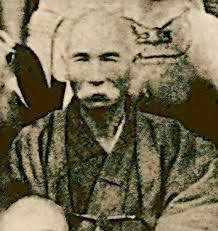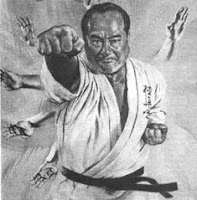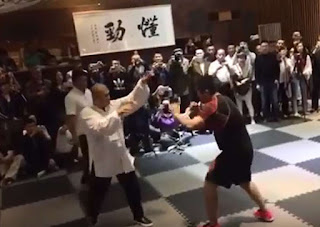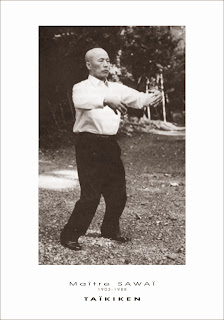The face of Itosu
Few karate masters have exerted as much influence as Yasatsune "Anko" Itosu (1831 – 11 March 1915) - the alleged creator of the pinan kata and possibly the naihanchi series; teacher of such luminaries as Gichin Funakoshi, Choki Motobu, Chomo Hanashiro, Chotoku Kyan, Shinpan Shiroma, Choshin Chibana and Kenwa Mabuni - among many others.
 It would be fair to say that, while his legendary teacher Sokon Matsumura is regarded as the start point of the Suidi or Shorin school of karate, the real "father" of this school was Itosu.
It would be fair to say that, while his legendary teacher Sokon Matsumura is regarded as the start point of the Suidi or Shorin school of karate, the real "father" of this school was Itosu.
I will let you read Tom Ross's excellent articles on Fightingarts.com concerning the man and his legacy. I also invite you to read my article on the Channan kata and on the origins of Naihanchi.
But what did Itosu look like? Is the picture to the right really him?
Until 2006 the only images we had of Itosu were drawings - and conflicting ones at that. Specifically there were 3 main ones to be found on the net.
Two seemed quite similar, depicting Itosu's famously fierce gaze. Indeed, if I were to hazard a guess, I'd say one was actually based on the other (as was common during that era - they didn't have photocopiers or digital images to download!).
 These drawings imply that Itosu was a broad shouldered, physically imposing man, so at least in this respect they seem to be accurate.
These drawings imply that Itosu was a broad shouldered, physically imposing man, so at least in this respect they seem to be accurate.
[Indeed, somewhere around 2006/7, I removed the photograph at the start of this essay from my our Academy's karate history web page after receiving an email complaint from a high-ranking shorin-ryu karateka that this was "not Itosu" but rather another karate master (I seem to recall reference was made to Hanashiro Chomo). I replaced the photograph with the second of these images on the strength of that complaint (I was, at that time, unaware of the McCarthy article)!]
Notably, both pictures show an older man with a full head of hair, a beard and a thin moustache. I have not been able to find the source of these pictures, but I assume they were drawn based on verbal accounts rather than as part of a "portrait sitting".
On the other hand we also have third drawing of Itosu which can be found in Frank Hargrove's book "The 100 year history of shorin-ryu karate". Again, this drawing is said to be a composite based on oral descriptions.
The picture in Hargrove's book is notably used in the first of the Itosu articles by Tom Ross on Fightingarts.com.
Interestingly, this picture shows a younger man. He has no beard, a very thick moustache and, somewhat strangely, he is wearing a western shirt (typical of the late 1800s), suit and tie.
The salient point to note is that this third drawing seems to bear no resemblance whatsoever to the other two. Where the others seemed to be copied from each other (right down to the kimono neckline), this third drawing seems totally out of place. Who would think to draw a karate master in western garb? Why not show his famously broad shoulders?
Then on Tuesday 28 February 2006, Patrick and Yuriko McCarthy published the following article in the Okinawa Times, revealing the first known photograph of Itosu.
The picture was formerly in the possession of karate master Kinjo Hiroshi who donated it, along with 3,000 other photographs in his collection, to the Okinawa Prefecture Library to be used for historical research.
It was authenticated by Dr Kadekaru Toru the Ryukyu cultural anthropologist, and chief curator for Okinawa prefectural office of historically important documents.
It seems the photograph was taken in 1909 or 1910 when Itosu had started teaching middle school in Okinawa. If the date is correct, Itosu would have been around 78 or 79 at the time. It depicts Itsou as a bald, broad-shouldered man with a large moustache.
In a Facebook discussion I was informed by Scott Vogt (quoting his teacher, reknowned karate researcher Joe Swift, who was in turn reading from a Japanese-language martial arts magazine) that Kinjo Sensei received this photo in approximately 1980 from a man (apparently by the name of Arasaki) who in turn received it from a man named Tokuda - one is one of the students in the photo. According to Scott:
This was further clarified on the same Facebook thread by "Kuma Koryukan Frederick" as follows:
So where does this place the previously-mentioned drawings?
It seems to me that the first two are wildly off-base. But the third picture is intriguing: the moustache and general facial proportions seem to match. The biggest difference appears to be the full head of hair. But then again, men do tend to lose hair as they age.
Then I came across the image on this web page, purportedly showing not only Itosu, but a young Gichin Funakoshi (and even, improbably, Kenwa Mabuni) taken circa 1880.
[I say "improbably" in relation to Mabuni because, as was pointed out by Mike Akins, if the photograph was taken in 1880, that would make Itosu (seated) around 49, Funakoshi (to the right) around 12 - with Mabuni (purportedly standing) yet to be born for another 9 years or so!]
What of the suggestion that the picture shows Funakoshi? I'd say the likelihood is high based on physical features. Indeed, the trademark look seems immediately apparent - at least to me! [I can see why someone might have thought the standing figure was Mabuni - but really, the resemblance is nothing more than passing compared to the boy who looks like Funakoshi.]
So what of the suggestion that the seated adult is Itosu? I can't help but observe that there is an almost identical match between this man and the man depicted in the "third" drawing of Itosu above. Note the western suit and tie - right down the collar. Certainly the moustache is the same. If it weren't for the shorter hair cut, I might have assumed the drawing was copied from this photograph.
Unfortunately, the site makes no reference to where this photograph was sourced. It might, or might not, be Itosu. I initially thought that it would be highly unlikely for it to have been Itosu for one specific reason: he seemed to have too much hair. I reasoned that men who exhibit male-pattern baldness typically do so from a younger age. Itosu was more or less bald in his late 70s as shown in the authenticated picture - yet here, in his late 40s, he still has a full head of hair.
Synchronously however, I happened to be reading about Ron van Clief. I noted that he still had a full head of hair in his late 40s and early 50s.
But now he is almost completely bald.
It seems that my reasoning regarding male-pattern baldness was incorrect: at least some men can keep a full head of hair through middle age, only to lose it in later life (I'm assuming here that van Clief isn't just shaving his head as a fashion statement).
This made me revisit this photograph, the third drawing and the authenticated one. I now lean towards the view that the 1880 photo does indeed show a middle-aged Itosu. I reach this conclusion tentatively, based on the fact that the physical features (eg. the moustache, chin, eyes) match, as well as the similarity between the third drawing and the 1880 photo (right down to the part in the hair, the moustache and the suit/tie/collar).
So I will conclude (at least until better evidence comes along) that there are in fact two extant photographs of Itosu: one (authenticated) one of Itosu in his late 70s, and one (unauthenticated) one of him from 30 years earlier.
If anyone has any information about the 1880 photo, I'd love to hear from you!
In the meantime, my friend Lindsay McKenzie has also alerted me to the photo from Richard Kim's book "Weaponless Warriors" of Gichin Funakoshi (seated with arms crossed?) and some school students (who, it seems, were karate students of Funakoshi's colleague and fellow Itosu student, Kentsu Yabu). It was taken on 6 March 1921 shortly before an exhibition before Prince Hirohito. Yabu was away in the US during this demonstration, requiring Funakoshi to fill in as the demonstration leader.
It is significant to note that the photo was originally published Funakoshi's 1922 book "Ryukyu Kempo" (a year after the demo) - subsequently republished as "Karate Jutsu". Why it this significant? Because it shows that the photograph was selected by Funakoshi as representative of his art of karate - including his lineage.
Accordingly I think it is reasonable to assume that the photograph depicts Anko Itosu on the right insert (note the same collar and suit) and Anko Azato on the left insert - since both were Funakoshi's karate teachers.
In fact, I would be flabbergasted if these insert pictures didn't depict Azato and Itosu: karate is very much an art in which one's teachers are revered: As Mark Chisenhall put it "If I were putting a picture together of a famous and prestigious event such as demostrating in front of the emperor of Japan, I would include a reference to my teachers. For without our teachers, the event would not be possible." I think it is doubly so when you are putting together a picture for your own book on karate.
So I think the only real question is who is who. I think there can be no real doubt that the picture on the right is Itosu given the congruence with the drawing and the 1880 picture.
The Itosu picture on the right seems to from around 1890 to 1900. I note that the hair seems to be thinning (relative to the drawing and the 1880 picture).
Otherwise, I think the congruence of these pictures is undeniable: this is indeed the face of
Anko Itosu.
Copyright © 2013 Dejan Djurdjevic
 It would be fair to say that, while his legendary teacher Sokon Matsumura is regarded as the start point of the Suidi or Shorin school of karate, the real "father" of this school was Itosu.
It would be fair to say that, while his legendary teacher Sokon Matsumura is regarded as the start point of the Suidi or Shorin school of karate, the real "father" of this school was Itosu.I will let you read Tom Ross's excellent articles on Fightingarts.com concerning the man and his legacy. I also invite you to read my article on the Channan kata and on the origins of Naihanchi.
But what did Itosu look like? Is the picture to the right really him?
Two seemed quite similar, depicting Itosu's famously fierce gaze. Indeed, if I were to hazard a guess, I'd say one was actually based on the other (as was common during that era - they didn't have photocopiers or digital images to download!).
 These drawings imply that Itosu was a broad shouldered, physically imposing man, so at least in this respect they seem to be accurate.
These drawings imply that Itosu was a broad shouldered, physically imposing man, so at least in this respect they seem to be accurate. [Indeed, somewhere around 2006/7, I removed the photograph at the start of this essay from my our Academy's karate history web page after receiving an email complaint from a high-ranking shorin-ryu karateka that this was "not Itosu" but rather another karate master (I seem to recall reference was made to Hanashiro Chomo). I replaced the photograph with the second of these images on the strength of that complaint (I was, at that time, unaware of the McCarthy article)!]
Notably, both pictures show an older man with a full head of hair, a beard and a thin moustache. I have not been able to find the source of these pictures, but I assume they were drawn based on verbal accounts rather than as part of a "portrait sitting".
On the other hand we also have third drawing of Itosu which can be found in Frank Hargrove's book "The 100 year history of shorin-ryu karate". Again, this drawing is said to be a composite based on oral descriptions.
The picture in Hargrove's book is notably used in the first of the Itosu articles by Tom Ross on Fightingarts.com.
Interestingly, this picture shows a younger man. He has no beard, a very thick moustache and, somewhat strangely, he is wearing a western shirt (typical of the late 1800s), suit and tie.
The salient point to note is that this third drawing seems to bear no resemblance whatsoever to the other two. Where the others seemed to be copied from each other (right down to the kimono neckline), this third drawing seems totally out of place. Who would think to draw a karate master in western garb? Why not show his famously broad shoulders?
Then on Tuesday 28 February 2006, Patrick and Yuriko McCarthy published the following article in the Okinawa Times, revealing the first known photograph of Itosu.
The picture was formerly in the possession of karate master Kinjo Hiroshi who donated it, along with 3,000 other photographs in his collection, to the Okinawa Prefecture Library to be used for historical research.
It was authenticated by Dr Kadekaru Toru the Ryukyu cultural anthropologist, and chief curator for Okinawa prefectural office of historically important documents.
In a Facebook discussion I was informed by Scott Vogt (quoting his teacher, reknowned karate researcher Joe Swift, who was in turn reading from a Japanese-language martial arts magazine) that Kinjo Sensei received this photo in approximately 1980 from a man (apparently by the name of Arasaki) who in turn received it from a man named Tokuda - one is one of the students in the photo. According to Scott:
"Tokuda-san said that Itosu is in this photo. Kinjo Sensei was unable to meet with Tokuda-san and figure out which one was Itosu. Tokuda-san subsequently passed away. In 1985 Kinjo-Sensei met with the son of Tokuda-san who confirmed that his father was in this photo but not which one was Itosu. Kinjo Sensei also met with the grandson of Itosu who could only say that he had faint memories of his grandfather but remembered facial hair but could not say whether it was a beard, mustache or both. In 2006 Kinjo sent some of his collection to the Okinawa museum and a curator there (I don’t know his name) digitized the photo and used computer enhancement to reveal more detail. The hands of the older, mustached gentleman showed large knuckles indicative of makiwara training. Also other descriptions of Itosu mention wearing an older kimono with no family crest. Taking all of these things together it was concluded by the museum curator that the older man with the mustache, large knuckles and plain kimono was Itosu."I take it that the "museum curator" referred to is Dr Kadekaru Toru who authenticated the picture.
This was further clarified on the same Facebook thread by "Kuma Koryukan Frederick" as follows:
"Arasaki Seibin (the late honorary professor of Tokyo University) received the photo from Tokuda Antei’s [personal] album (Tokuda was an early student of Itosu’s) The photo was taken to commemorate a judo & kendo competition [probably held at Okinawa Prefectural Middle School] You can clearly see the judo and Kendo participants in the full photo. The school principle Okubo Shuhachi, and Judo Sensei Ikeda Takehiko are also in the photo. The photo was digitized and authenticated by Kadekaru Toru, the chief specialist from the Okinawa prefectural office of historically important documents."It seems beyond doubt that this is indeed the face of Itosu - the cropped one featuring at the start of this essay.
So where does this place the previously-mentioned drawings?
It seems to me that the first two are wildly off-base. But the third picture is intriguing: the moustache and general facial proportions seem to match. The biggest difference appears to be the full head of hair. But then again, men do tend to lose hair as they age.
Then I came across the image on this web page, purportedly showing not only Itosu, but a young Gichin Funakoshi (and even, improbably, Kenwa Mabuni) taken circa 1880.
[I say "improbably" in relation to Mabuni because, as was pointed out by Mike Akins, if the photograph was taken in 1880, that would make Itosu (seated) around 49, Funakoshi (to the right) around 12 - with Mabuni (purportedly standing) yet to be born for another 9 years or so!]
What of the suggestion that the picture shows Funakoshi? I'd say the likelihood is high based on physical features. Indeed, the trademark look seems immediately apparent - at least to me! [I can see why someone might have thought the standing figure was Mabuni - but really, the resemblance is nothing more than passing compared to the boy who looks like Funakoshi.]
So what of the suggestion that the seated adult is Itosu? I can't help but observe that there is an almost identical match between this man and the man depicted in the "third" drawing of Itosu above. Note the western suit and tie - right down the collar. Certainly the moustache is the same. If it weren't for the shorter hair cut, I might have assumed the drawing was copied from this photograph.
Unfortunately, the site makes no reference to where this photograph was sourced. It might, or might not, be Itosu. I initially thought that it would be highly unlikely for it to have been Itosu for one specific reason: he seemed to have too much hair. I reasoned that men who exhibit male-pattern baldness typically do so from a younger age. Itosu was more or less bald in his late 70s as shown in the authenticated picture - yet here, in his late 40s, he still has a full head of hair.
Synchronously however, I happened to be reading about Ron van Clief. I noted that he still had a full head of hair in his late 40s and early 50s.
But now he is almost completely bald.
It seems that my reasoning regarding male-pattern baldness was incorrect: at least some men can keep a full head of hair through middle age, only to lose it in later life (I'm assuming here that van Clief isn't just shaving his head as a fashion statement).
This made me revisit this photograph, the third drawing and the authenticated one. I now lean towards the view that the 1880 photo does indeed show a middle-aged Itosu. I reach this conclusion tentatively, based on the fact that the physical features (eg. the moustache, chin, eyes) match, as well as the similarity between the third drawing and the 1880 photo (right down to the part in the hair, the moustache and the suit/tie/collar).
So I will conclude (at least until better evidence comes along) that there are in fact two extant photographs of Itosu: one (authenticated) one of Itosu in his late 70s, and one (unauthenticated) one of him from 30 years earlier.
If anyone has any information about the 1880 photo, I'd love to hear from you!
In the meantime, my friend Lindsay McKenzie has also alerted me to the photo from Richard Kim's book "Weaponless Warriors" of Gichin Funakoshi (seated with arms crossed?) and some school students (who, it seems, were karate students of Funakoshi's colleague and fellow Itosu student, Kentsu Yabu). It was taken on 6 March 1921 shortly before an exhibition before Prince Hirohito. Yabu was away in the US during this demonstration, requiring Funakoshi to fill in as the demonstration leader.
It is significant to note that the photo was originally published Funakoshi's 1922 book "Ryukyu Kempo" (a year after the demo) - subsequently republished as "Karate Jutsu". Why it this significant? Because it shows that the photograph was selected by Funakoshi as representative of his art of karate - including his lineage.
Accordingly I think it is reasonable to assume that the photograph depicts Anko Itosu on the right insert (note the same collar and suit) and Anko Azato on the left insert - since both were Funakoshi's karate teachers.
In fact, I would be flabbergasted if these insert pictures didn't depict Azato and Itosu: karate is very much an art in which one's teachers are revered: As Mark Chisenhall put it "If I were putting a picture together of a famous and prestigious event such as demostrating in front of the emperor of Japan, I would include a reference to my teachers. For without our teachers, the event would not be possible." I think it is doubly so when you are putting together a picture for your own book on karate.
So I think the only real question is who is who. I think there can be no real doubt that the picture on the right is Itosu given the congruence with the drawing and the 1880 picture.
The Itosu picture on the right seems to from around 1890 to 1900. I note that the hair seems to be thinning (relative to the drawing and the 1880 picture).
Otherwise, I think the congruence of these pictures is undeniable: this is indeed the face of
Anko Itosu.
Copyright © 2013 Dejan Djurdjevic










Comments
Post a Comment